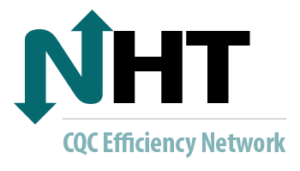CQC Results Excecutive Summary 2025
The CQC results indicate that member authorities have generally improved efficiency and effectiveness since 2014.
The CQC framework distinguishes between genuine efficiency gains (from improved practices) and simple budget cuts
Here are the Headline Trends from the NHT Cost, Quality, Customer Framework. CQC)
| Metric | Results | Network Trend / Comment |
| Average Efficiency Score | 91% | Network efficiency has risen slightly overall (+1–2%). Most authorities operate between 85–95%, showing convergence and maturity in efficiency practices. |
| Highest Efficiency Scores | A few top authorities (scoring 98–100%) are now operating very close to their Predicted Minimum Cost, indicating fully optimised performance. | |
| Lowest Efficiency Scores | 62–70% | A minority of authorities remain significantly below the network average, often due to local constraints (geography, asset condition, or cost pressures). |
| Average Efficiency Improvement Since 2013/14 | 11% | Typically members have reduced their effective cost base by around 11%, equivalent to substantial long-term savings without degradation in service quality. |
| Cumulative Efficiency Savings (since 2013/14) | Typically £10–30M per authority, network total in the hundreds of millions | Demonstrates significant and sustained real savings achieved through improved processes, asset management, and procurement. |
| Average Opportunity Gap (Scope for Improvement) | 9% | The network still has about 9% efficiency potential before reaching predicted minimum cost—suggesting further gains possible. |
Common Patterns Across the Membership
1. General Upward Trend in Efficiency:
Nearly all authorities show improvement since 2014, with most recording increases in their Efficiency Score. This reflects widespread adoption of leaner operating models, better asset management data, and integrated planning.
2. Convergence Toward Network Average:
The variation between authorities has narrowed—indicating shared learning and benchmarking are helping raise the baseline.
3. Catch-Up Vs Keep-Up Improvements:
- Keep-Up improvements (steady continuous gains) are consistently reported across the network.
- Catch-Up improvements (closing historical gaps) vary more widely—some authorities have achieved double-digit catch-up gains, while a few still lag behind.
4. Stable or Rising Service Quality:
The increase in efficiency scores without major cost spikes suggests savings have been realised through process improvements, not through service reduction.
5. Network Learning Effect:
Authorities that benchmark regularly against their peers show the strongest and most sustained improvement—indicating that CQC benchmarking itself is driving better management practices.
Summary Indicators for the Network
- Average Overall Improvement: 11% since 2013/14
- Average Annual Efficiency Savings (2024/25): Typically £0.5M–£3M per authority
- Cumulative Savings (since 2013/14): Commonly £10–30M, with some large authorities exceeding £50–70M
- Efficiency Score Range (2025): 62%–100%
- Network Average Efficiency Score: 91%
- Average Opportunity Gap: 9%
In Summary
-
- Sustained real efficiency gains across the network (11% improvement since 2014).
- Reduced variation between authorities, signalling consistent adoption of good practice.
- High cumulative savings, demonstrating genuine productivity improvement.
- A remaining efficiency potential of around 9%, suggesting scope for further optimisation through innovation and cross-authority collaboration.
